Let’s talk shop safety! It’s an exciting topic, right? Not really. But it is a necessary topic to discuss. Before we begin know that I’m not an expert at any of this. I’m just someone who has been active almost daily in a woodshop of some kind for the past decade and I regularly have other people working in my shop with me. Many of whom have zero woodworking knowledge and safety training for working with tools. For that reason, I have many duplicates and have tried many options. I also get direct feedback from other people who do or do not like certain options.
So don’t take any of this information as instruction but rather my perspective. Also, I said before “we” begin. That’s because I want community involvement here. I’m sure there are a lot of things I forgot or simply overlooked. If you have any comments to add PLEASE DO SO! You will help someone out there. The video is an hour-long because it is more of a discussion, including why instead of just what. This article is the condensed version. This article does contain affiliate links.
Personal Protective Equipment (PPE)
Eye, ear, skin, and lungs…
Safety Glasses
You can hold stuff with a wooden hand and walk on a wooden leg but you can’t see with a wooden eye. That’s a saying that has stuck with me for many years. Bottom line, your eyes are delicate and when they are gone they are gone. Protect them! In the following image I give the two on the left a thumbs down and the two on the right a thumbs up.
The red pair is a cheap-o style you can get just about anywhere. I bought a bulk pack on Amazon a while ago just to have extras in the shop. I paid $15 for a 12 pack. Better than nothing, I suppose. Too bulky and rigid. They hurt the back of my ears after a while. 4th place, thumbs down.
The black and yellow pair is from Harbor Freight. They were $6 if I recall correctly. The nose area is too narrow for me. Maybe I have a big nose. They sit really high on my nose which causes a big gap above my nose and below the lenses by my cheeks. Third place, thumbs down.
The blue pair is the 3M Virtua CCS. I like these and so has everyone else who has tried them. They come with a clip-on foam gasket that I don’t use. The sides are a bit bulky but they don’t hurt my head after hours of use. I’ve used these for the past couple of years. Second place, thumbs up.
The cheapest place I have found the 3M Virtua was on Amazon. They are about $8 a pair.
The black and green 3M SecureFit pair on the right is my favorite. The best of all three to the left and still inexpensive than most. They resemble the red pair but have an adjustable nose piece and the sides are super thin and flexible. No more sitting high and no digging into the side of my head. And because the sides are thin they work great with earmuffs. First place, thumbs up.
Once I find a well-fitting pair of safety glasses I looked for a tinted version. That way I can keep getting the same pair over and over if they get damaged and know I’m going to get a pair that I like. It’s a better, and cheaper, strategy than getting cheap-o sunglasses at the gas station. Of course, tinted versions are available in both styles. Just like the safety glasses, the secure fit is now my go-to.
The Virtua tinted safety glasses are currently $9.58 on Amazon
The SecureFit tinted safety glasses are currently $3.99 at Taylor Toolworks.
Hearing Protection
Hearing protection is also a must. Unless you want to walk around saying “Huh?” and “Huh?” and “Huh?” prematurely. I’ve gone full circle with preferring earplugs vs ear muffs and also regular hearing protection vs hearing protection + music capability. I’m currently in the really inexpensive camp of corded foam earplugs. But first, let’s talk earmuffs.
The black pair on the left is the Howard Leight 1030110. I had these for a long time and while they are feature-rich, the noise reduction rating is only 25db. They have a 3.5mm input jack so you can use a Bluetooth adapter or a 3.5mm cable to your phone. I’m a bit neutral on these. I liked them while they lasted but the input jack wore out and the padding became too hard and comfortable to be used as a daily driver. I keep them for backup.
The Howard Leight 1030100 is about $29 on Amazon.
The pair on the right is from Harbor Freight. The noise reduction rating is only 23db and the strap on top is too small. These are good enough for kids or adults with a small head who won’t need hearing protection for an extended period of time. For longer needs, I’d recommend something with a better noise reduction rating.
The red and black pair in the middle is the 3M PELTOR Optime and by far my favorite earmuff style hearing protection. The foam padding is soft enough to be used with thicker safety glasses or with a hat. And the strap on top is long enough that I can wear them comfortably with a hat. These have a great noise reduction rating of 30db. Huge thumbs up.
The 3M PELTOR Optime is currently $29.99 at Taylor Toolworks
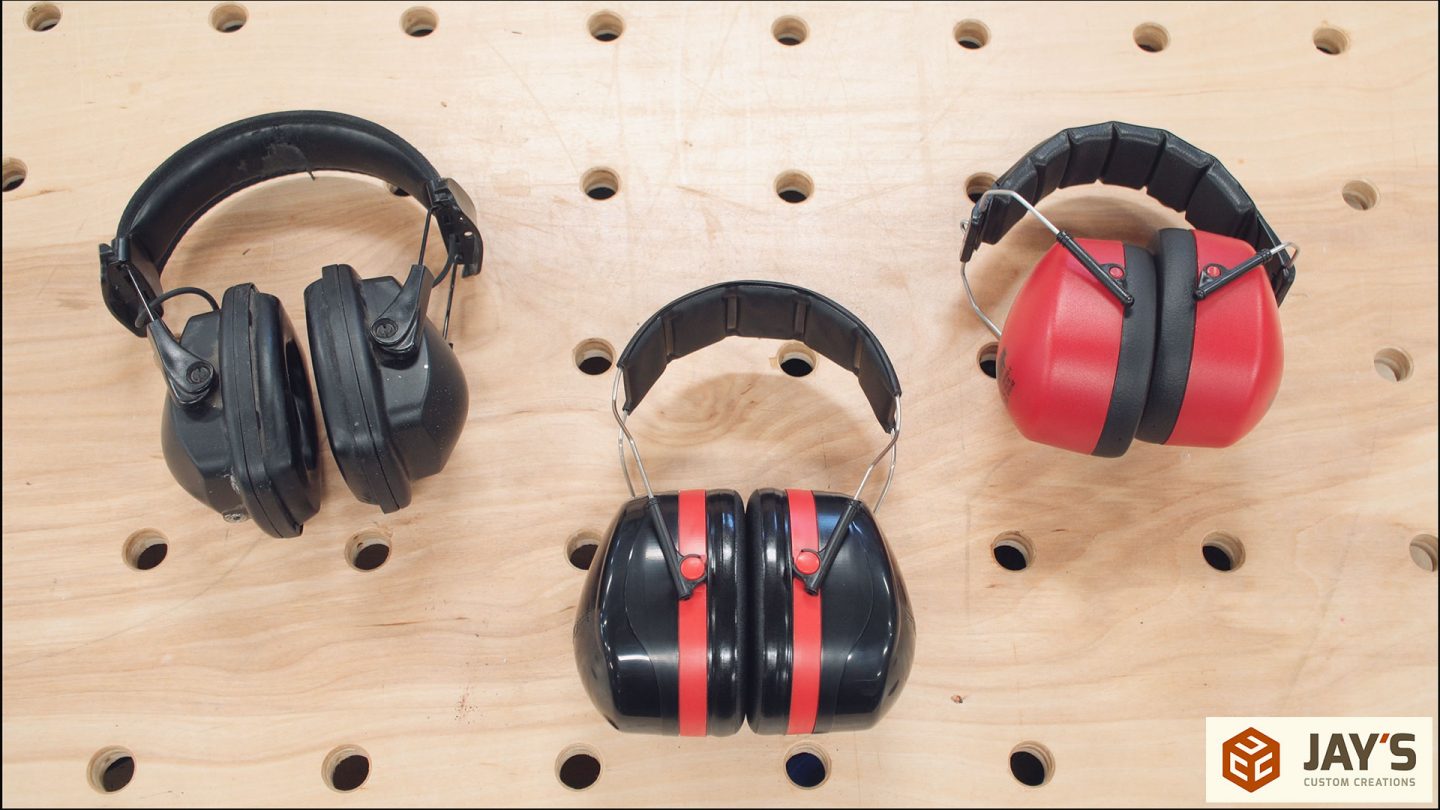
 For quick cuts or convenient hearing protection earmuffs are usually what I grab. But when I know I’m going to be in the shop for extended periods of time I now prefer earplugs. I’ve gone back and forth on plugs vs muffs but the older I get the more I appreciate the best hearing protection I can find. The greater the noise reduction rating the better. Here are all of the earplugs I keep on hand in the shop.
For quick cuts or convenient hearing protection earmuffs are usually what I grab. But when I know I’m going to be in the shop for extended periods of time I now prefer earplugs. I’ve gone back and forth on plugs vs muffs but the older I get the more I appreciate the best hearing protection I can find. The greater the noise reduction rating the better. Here are all of the earplugs I keep on hand in the shop.
Starting at the left is a cheap box of disposable foam plugs. I bought these a while ago and have held on to them as a backup. These have a noise reduction rating of 29 and you can find them just about anywhere.
Next is a bottle of The Ear Buddy foam plugs. These have a better noise reduction rating at 32db. Just like the cheap pack before, these are annoying to use because they don’t have a string to hang from the neck. It’s easy to set them down somewhere and accidentally lose one. I suppose that’s one reason why they are called disposable. I’ll give these a thumbs up because they work well but also a thumbs down because they lack a neck cord.
The Ear Buddy foam plugs are $18 on Amazon
I tried the Elgin Ruckus music enabled silicone plugs as they are a cheaper option for music and hearing protection. The Bluetooth, sound quality, and battery life are all good in my opinion but I realized after a few months of use that I wanted greater noise reduction again. These have a 25db noise reduction rating. I’ll give these a thumbs up because of the features but also a thumbs down because of only a 25db reduction.
The Elgin Ruckus music enabled silicone plugs are about $60 on Amazon.
The blue string pair is another silicone style plug with a cord. While at the same 25db noise reduction rating I felt like these blocked noises better than the Englin Ruckus. They are cheap and you can find them just about everywhere.
And finally, the best hearing protection that I’ve ever tried. Foam plugs on a cord with a noise reduction rating of 33db. These are comfortable for long stretches and do a great job blocking the noise. Although not convenient for quick cuts as the foam takes a minute or os to expand, they are my preferred hearing protection because of how well they block noise. Huge thumbs up.
Corded foam plugs are less than $4 for a 10 pack at Taylor Toolworks
Skin Protection
Gloves are great. Not only for protection against chemicals but also for added grip. I like to use thin nitrile gloves for added grip. Some people say you shouldn’t use gloves with power tools as they can get caught and pull your hand into the blade. These gloves are tight-fitting and if they get pulled into the blade then your too close anyway. These gloves will rip just like your flesh so the result will not be any different with or without thin gloves like these. Anyway, I recommend the AMMEX Gloveworks HD as they have bumps for increased traction. They are currently sold out on Amazon due to the COVID situation.
AMMEX Gloveworks HD are currently unavailable on Amazon. Check back later.
Lung Protection
Sometimes changing the environment isn’t always possible. In those cases, we need to protect our lungs from the pollutants in the air. That’s where respirators come into play. Unfortunately, I’m writing this article during the COVID situation which means our typical supply chain for woodworking related stuff has been changed. Luckily I found a good woodworking source for respirators.
The 6000 series of respirators from 3M is probably the most common out there. The 6200 is the standard medium size mask, pictured left in the first picture. The 6300 is the standard large size mask, in the second picture. And the 6503 is the large size with a flip-up quick release, pictured right in the first picture. I do not recommend the flip-up feature. I never use it. If I’m in a dirty environment where a respirator is necessary why would I want to flip it down to talk? Even if I step out for safer air I’d rather take the entire mask off to talk. I don’t recommend the extra cost for this feature. I do recommend the 6200 and 6300. Thumbs up.
The 6000 series of 3M respirators are about $18 at Taylor Toolworks
Regarding size, if you have facial hair I’d recommend starting at the large size. A medium will fit my face better if I shave but because I keep some facial hair the large seals better. It’s also important to make sure your mask is fitting properly.
Check out this guide for a quick test.
Because these can be used in a wide variety of situations with different dangers to deal with they do not come with filters. For woodworking, there are two types of filters to consider. All of the filter options attach to the respirator in the same way. There is a three-tab twist lock system.
First, a particulate filter like the 3M 2091 pink filters is good for particulates in the air. These have a P100 rating, meaning they capture 99.98% of particles down to .3 microns.
The P100 filters are currently $8.99 at Taylor Toolworks
Another danger to our lungs is harmful vapors, like lacquer fumes. Have you ever heard someone say they got high on paint fumes? That’s not a good thing. There are a lot of fumes in woodworking finishes that are hazardous to our health. That’s where an organic vapor cartridge comes into play. These cartridges protect against harmful fumes. There are a lot of different kinds out there for specific uses but a good one for woodworking is the 3M 6001i. I like this cartridge in particular because it has a service life indicator on it. The tab peals back to reveal the indicator. Put the tab back to keep the indicator from getting damaged or covered in overspray. FINALLY, a reliable way to know when the cartridge needs to be replaced instead of guessing.
The 3M 6001i organic vapor cartridge is $17.99 at Taylor Toolworks
So what about those situations where you need vapor protection as well as particulate protection? There’s a setup for that too. After installing the organic vapor cartridge an N95 filter can be attached with the help of a filter retainer. Then you have the best of both worlds. The N95 filter filters 95% of all particles down to .3 microns. N95 filters even filter out COVID-19 particles.
A pair of the 3M N95 filters for organic vapor cartridges are $3.99 at Taylor Toolworks
A pair of the filter retainers are $6.99 at Taylor Toolworks

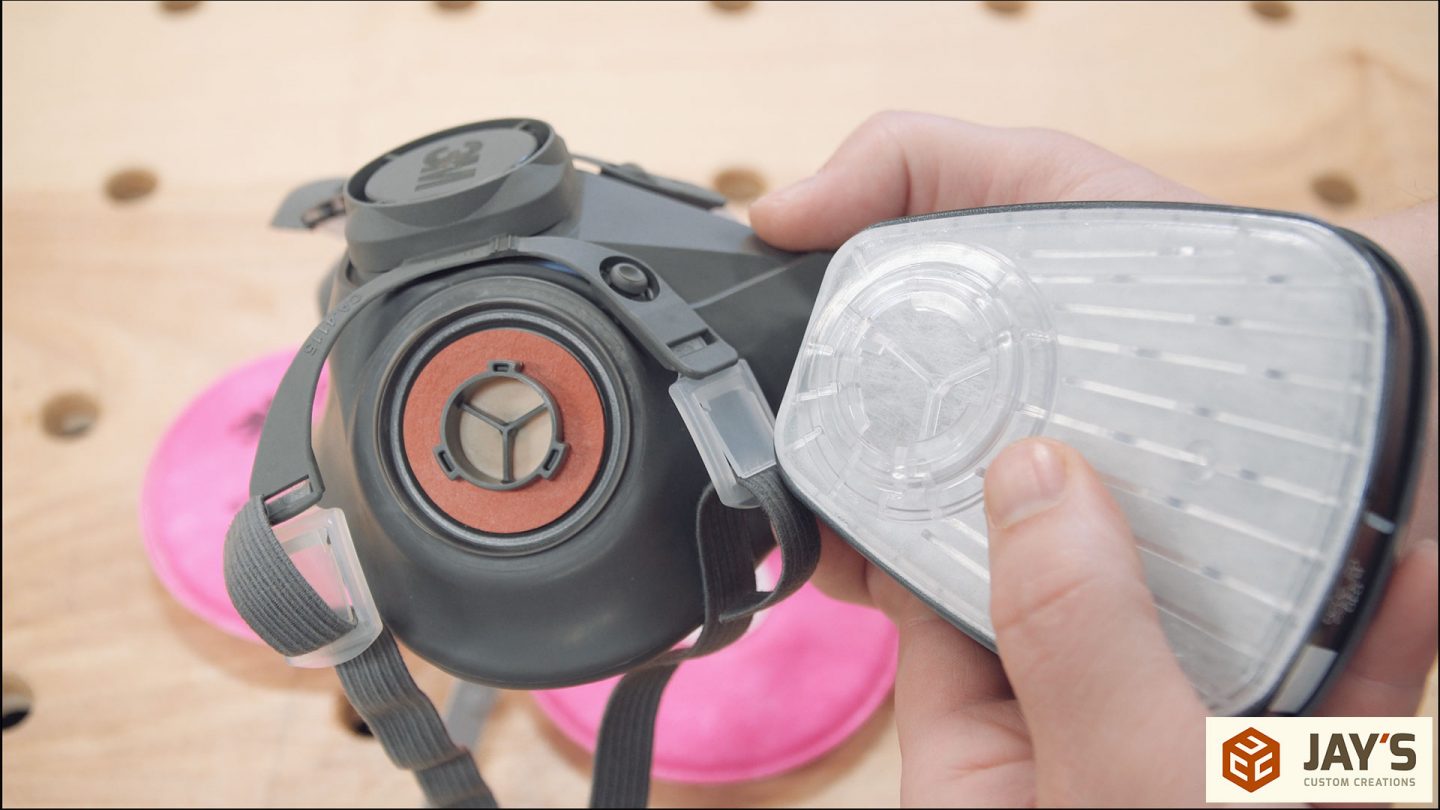
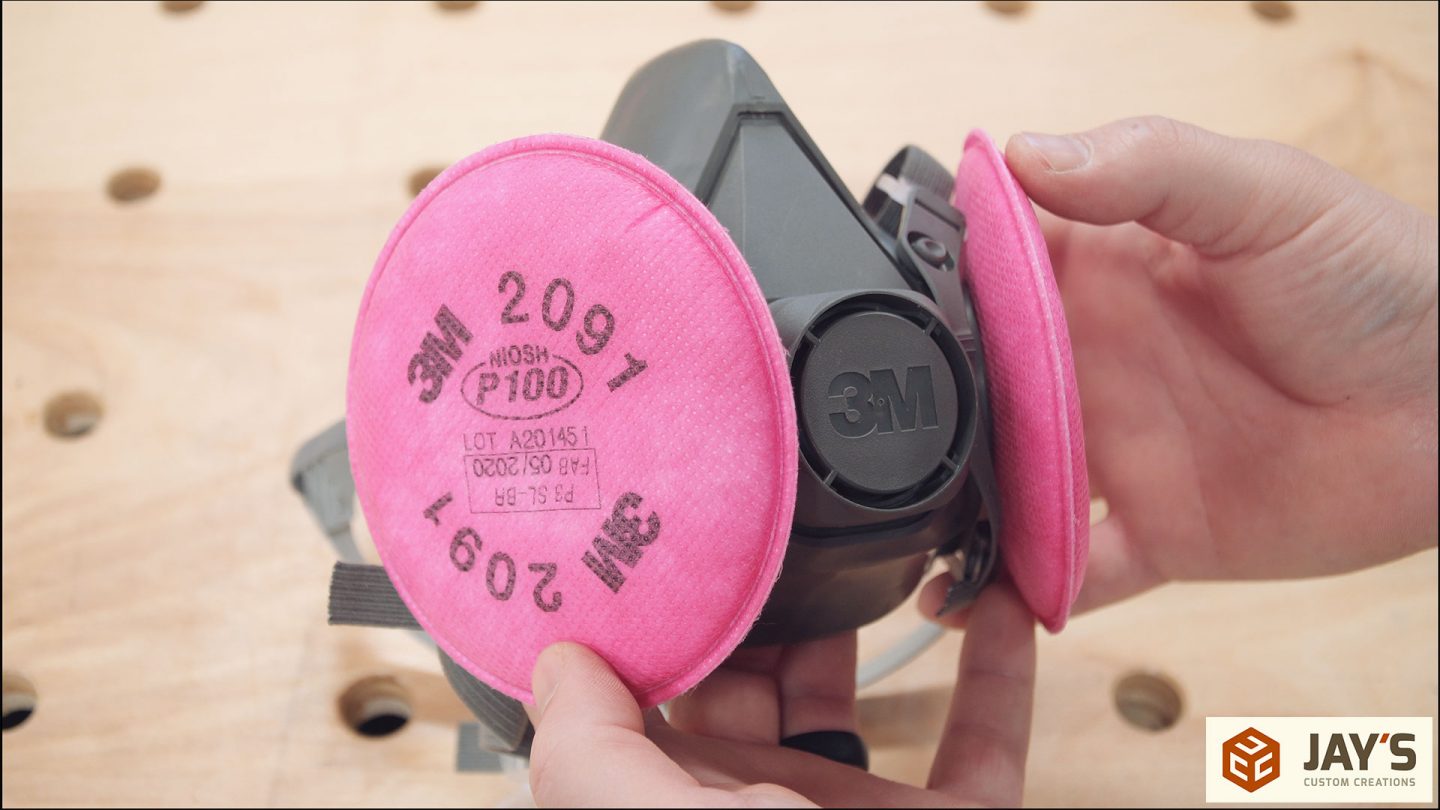
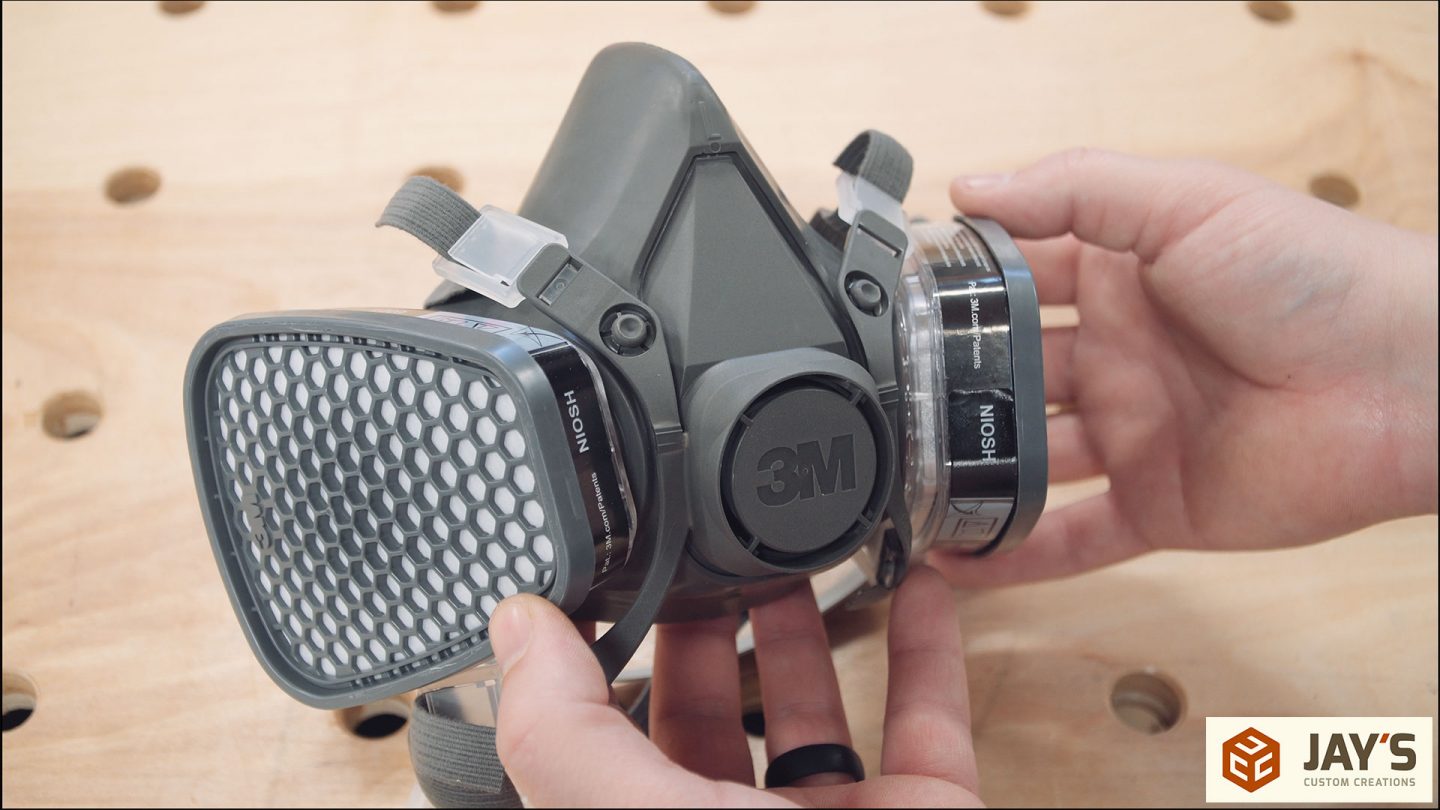
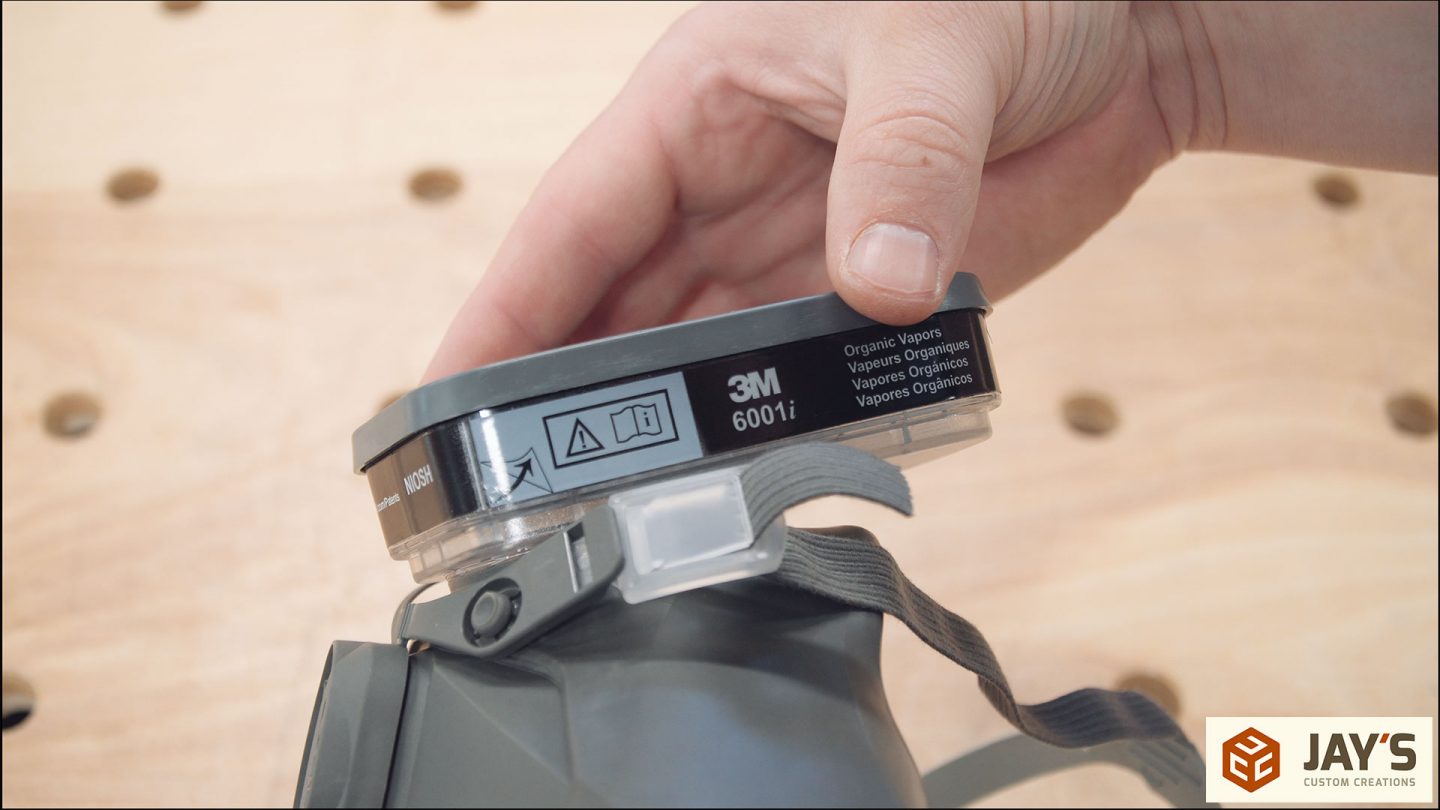
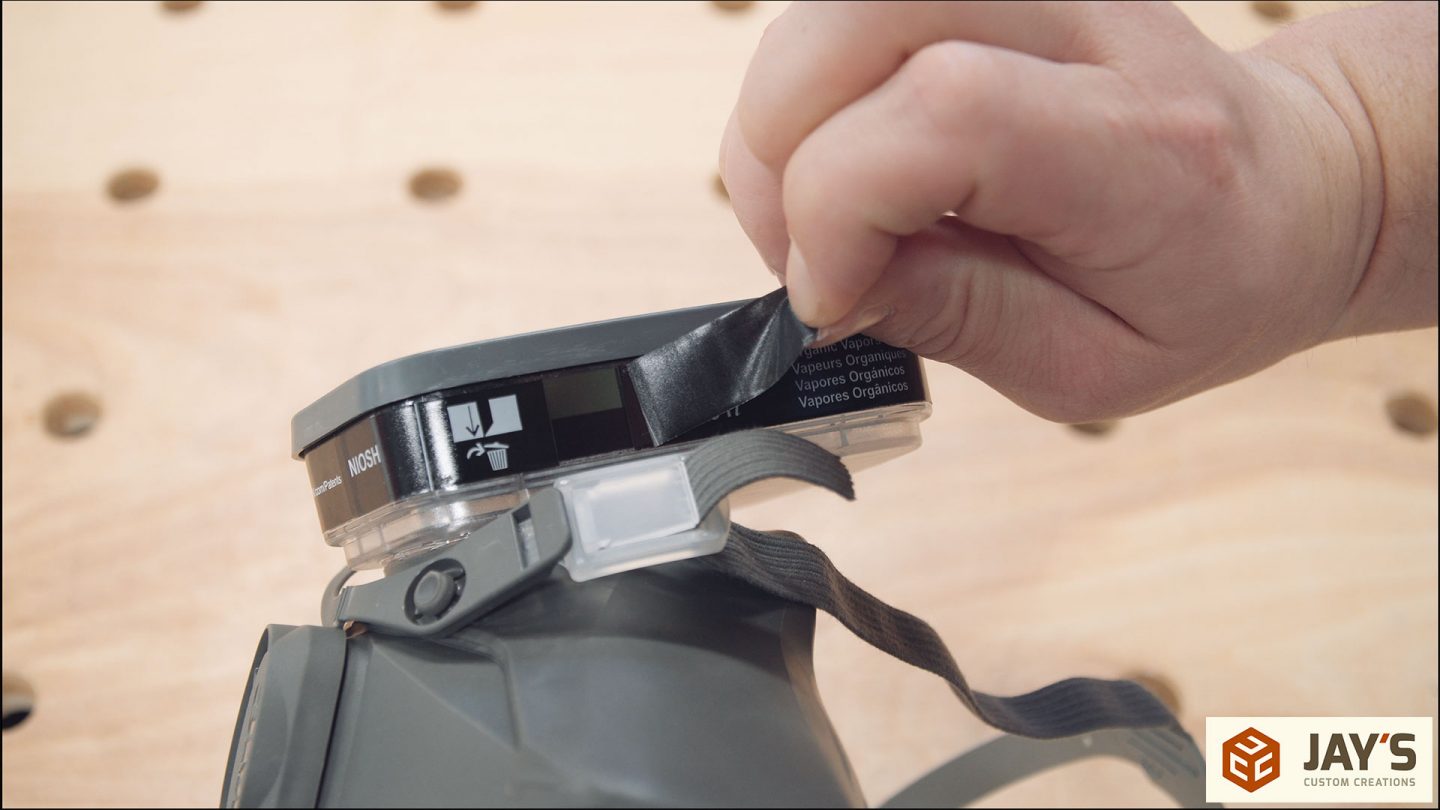
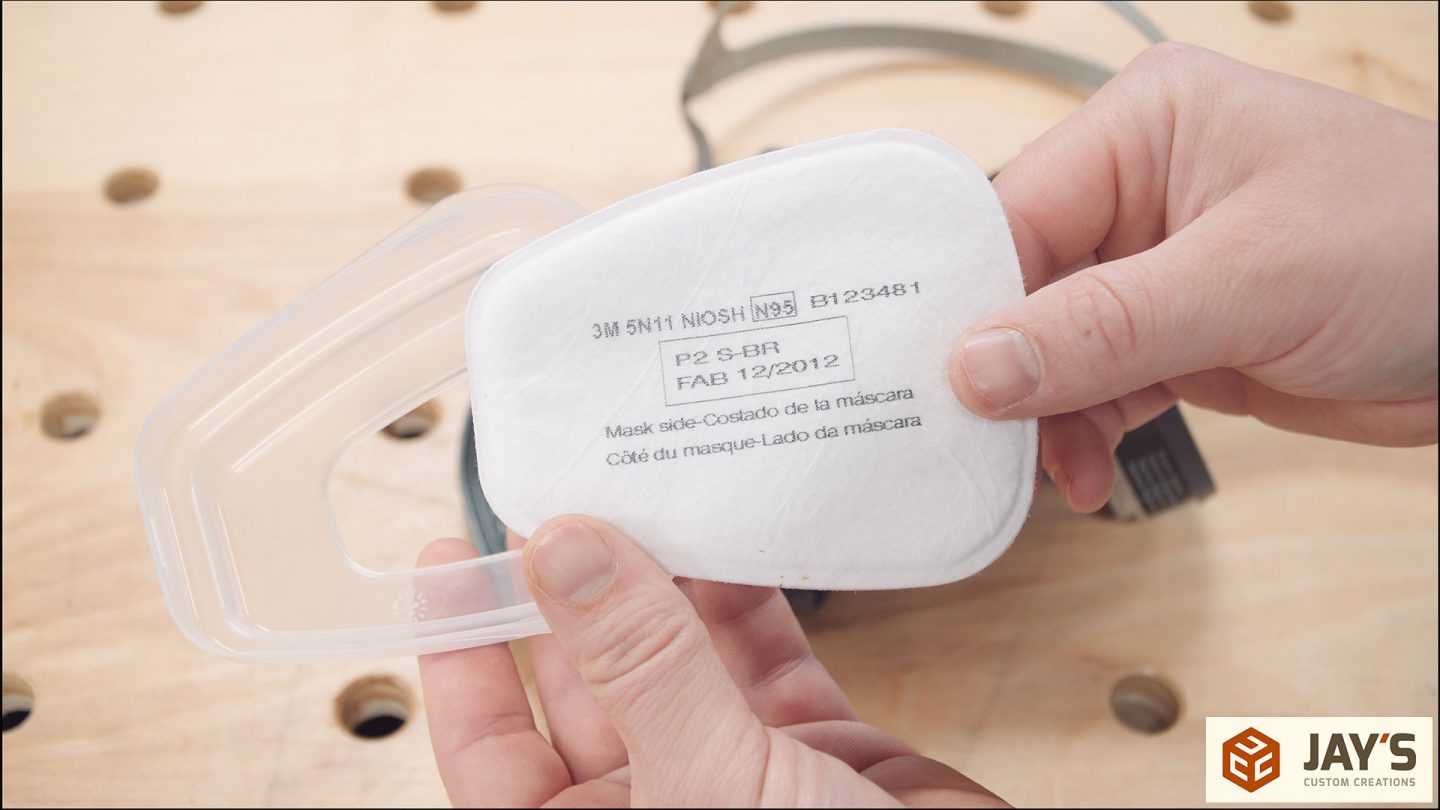
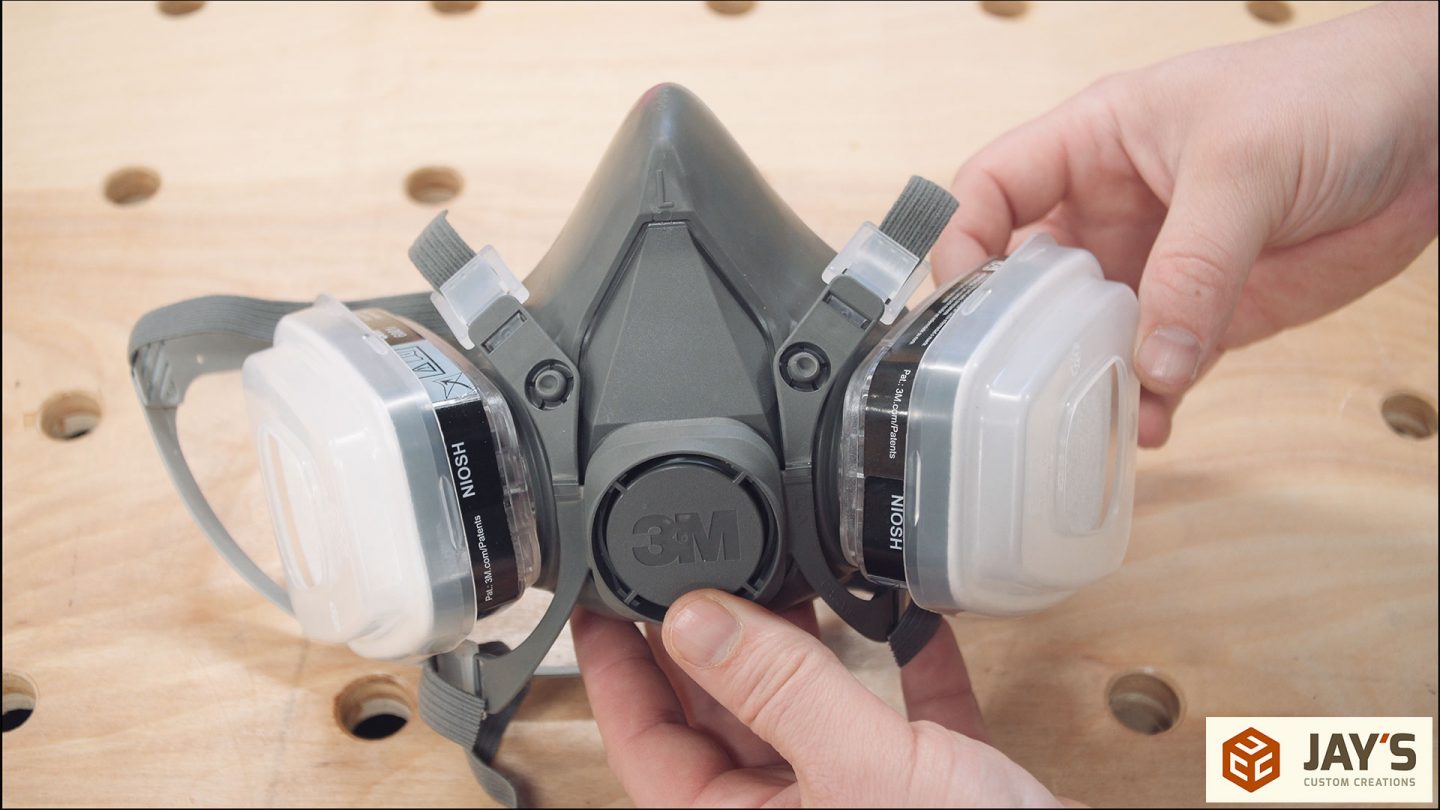 First Aid Kit
First Aid Kit
For woodworking first aid I’m thinking about the tools we use and how we can hurt ourselves with them. From basic cuts from chisels and saws to extreme situations like possible amputations from cutting off body parts. Writing that sentence even makes me shiver slightly. We hope we never see or experience those situations but it’s better to be prepared if possible.
For the basic stuff, I have a basic first aid kit. Bandaids, bandages, gauze, antiseptic wipes, alcohol wipes, cold pack, and some other generic stuff.
My 3M 118 piece first aid kit is $24.99 at Taylor Toolworks
I recommend a few additions to the standard first aid kit. First, a pack of waterproof bandaids. These aren’t because we swim in the woodshop but because they have adhesive on all sides of the bandage part. This prevents dust and debris from getting under the bandaid while in the dirty and dusty environment. These can be found pretty much anywhere.
I also highly recommend picking up the most amazing pair of tweezers I’ve ever used. These are the Uncle Bill’s Sliver Grippers. They are sharp and allow you to firmly grab anything that gets stuck in your skin. They do a GREAT job. I keep mine outside of my first aid kit and in a large paper pouch because I use them so frequently.
The Uncle Bill’s Sliver Gripper tweezers are $5.99 at Taylor Toolworks
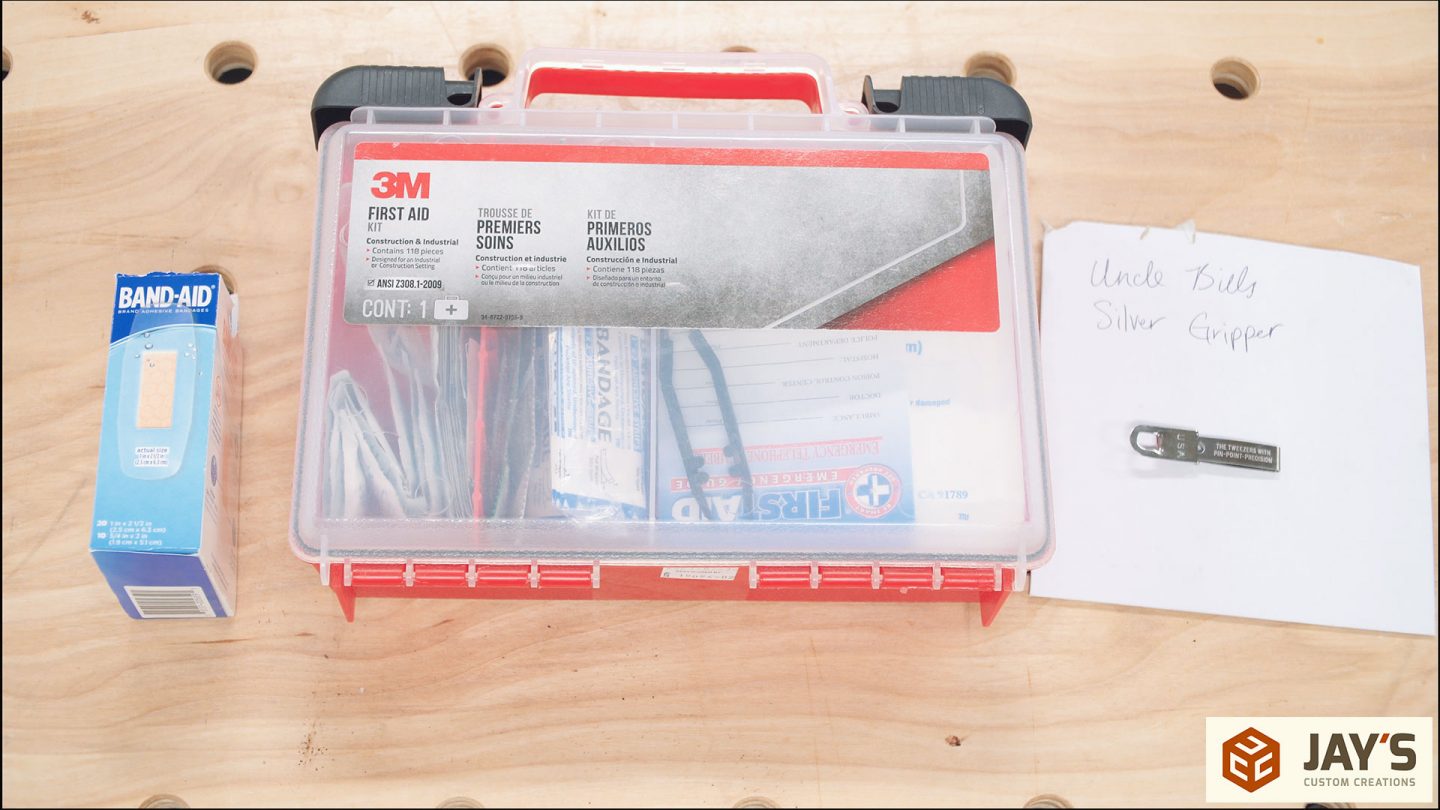
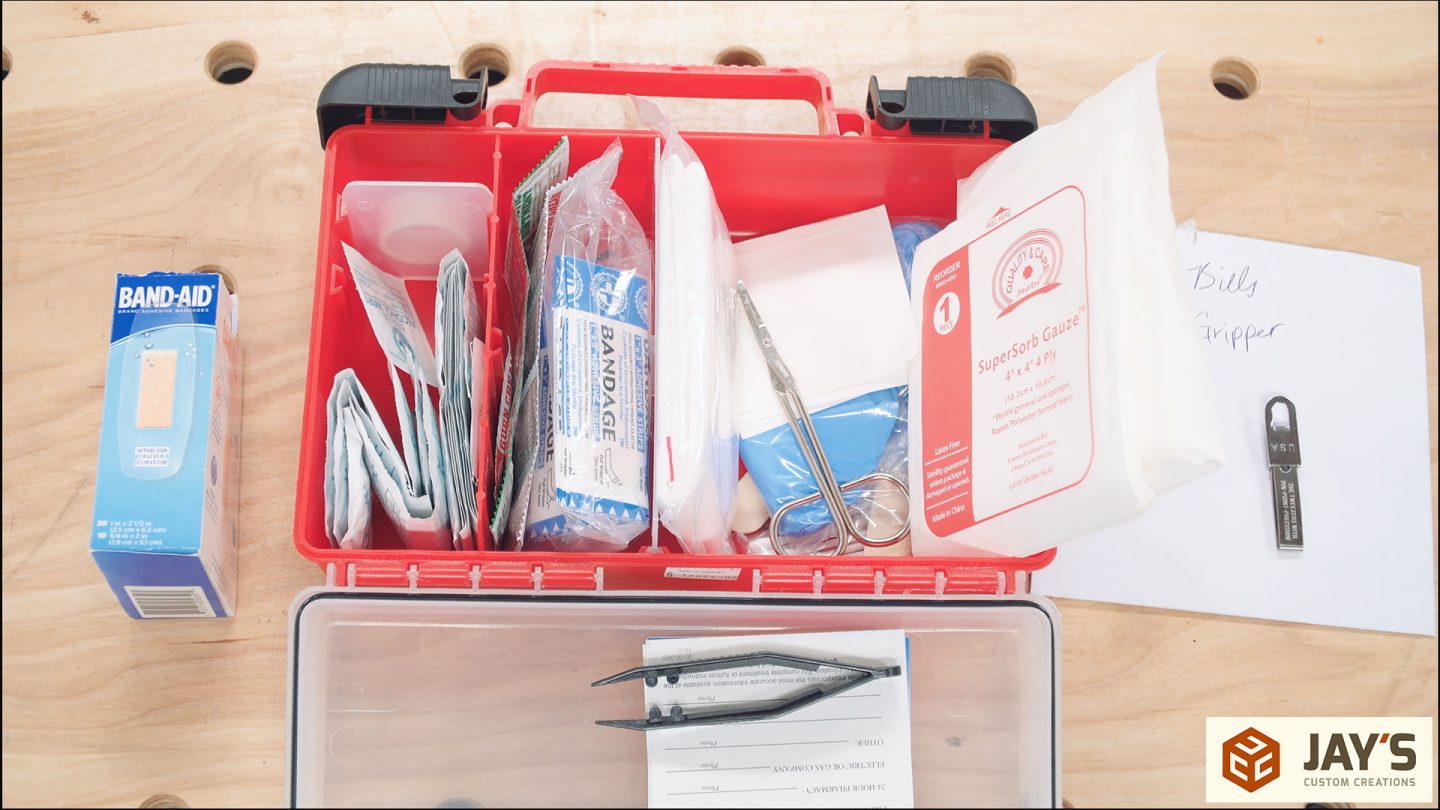

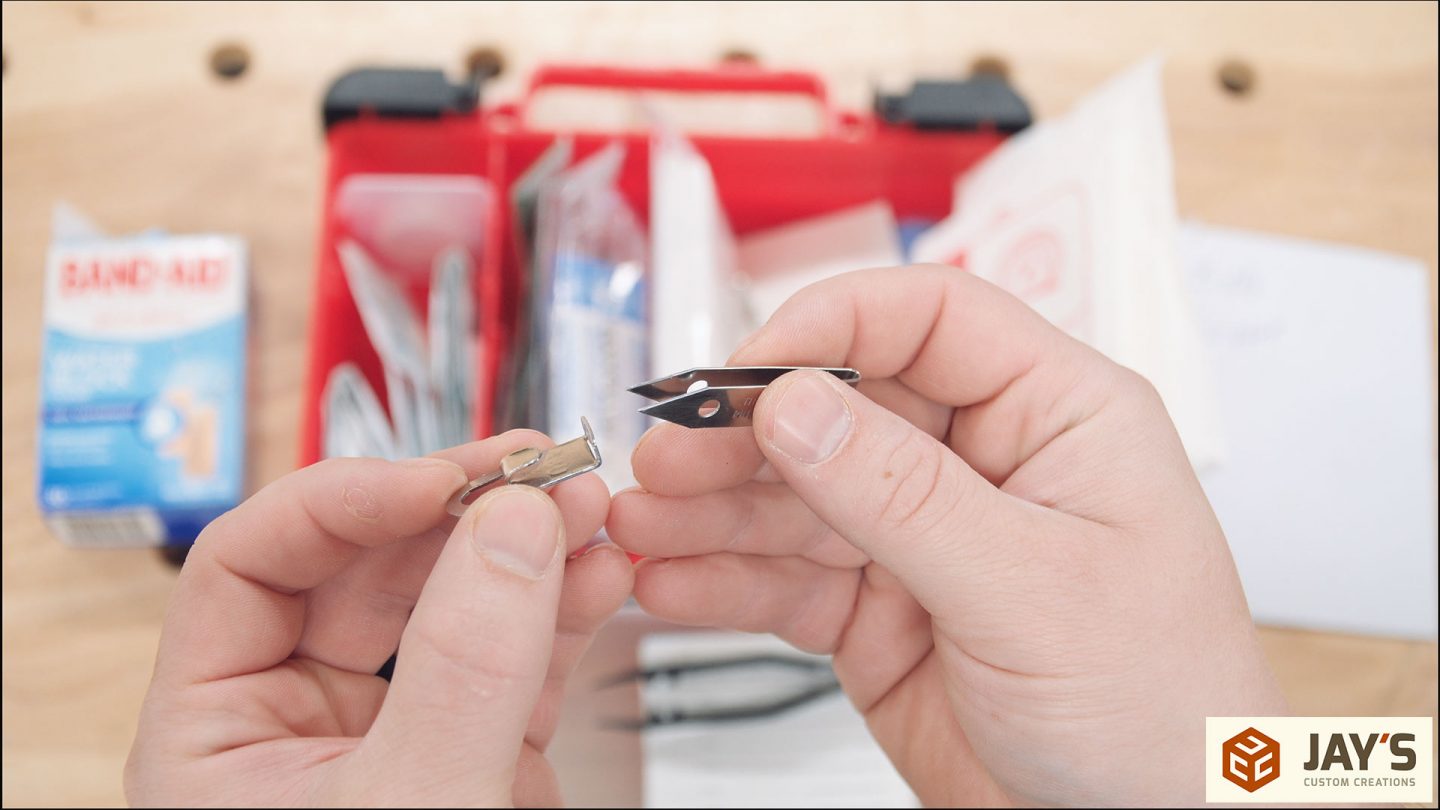 Lastly, prepare for an amputation. Again, I never want to see or experience one but I’d rather be prepared. I asked around and found this particular tourniquet as the most common recommendation. It’s a velcro tourniquet with an aluminum windlass (bar to twist) that allows for greater tightening. I recommend researching how to implement these properly. I picked up a few of these. One for the shop, one for each vehicle, and one for my shooting range IFAK (individual first aid kit).
Lastly, prepare for an amputation. Again, I never want to see or experience one but I’d rather be prepared. I asked around and found this particular tourniquet as the most common recommendation. It’s a velcro tourniquet with an aluminum windlass (bar to twist) that allows for greater tightening. I recommend researching how to implement these properly. I picked up a few of these. One for the shop, one for each vehicle, and one for my shooting range IFAK (individual first aid kit).
For the shop tourniquet, I keep it in a ziplock bag with an activated cold pack and the amputation bag that came with the tourniquet. That way I can put whatever was cut off in the original bag, activate the cold pack and keep both of those in the ziploc bag. Again, I hope I never have to use this stuff.
The Recon Medical tourniquet is $15.99 on Amazon
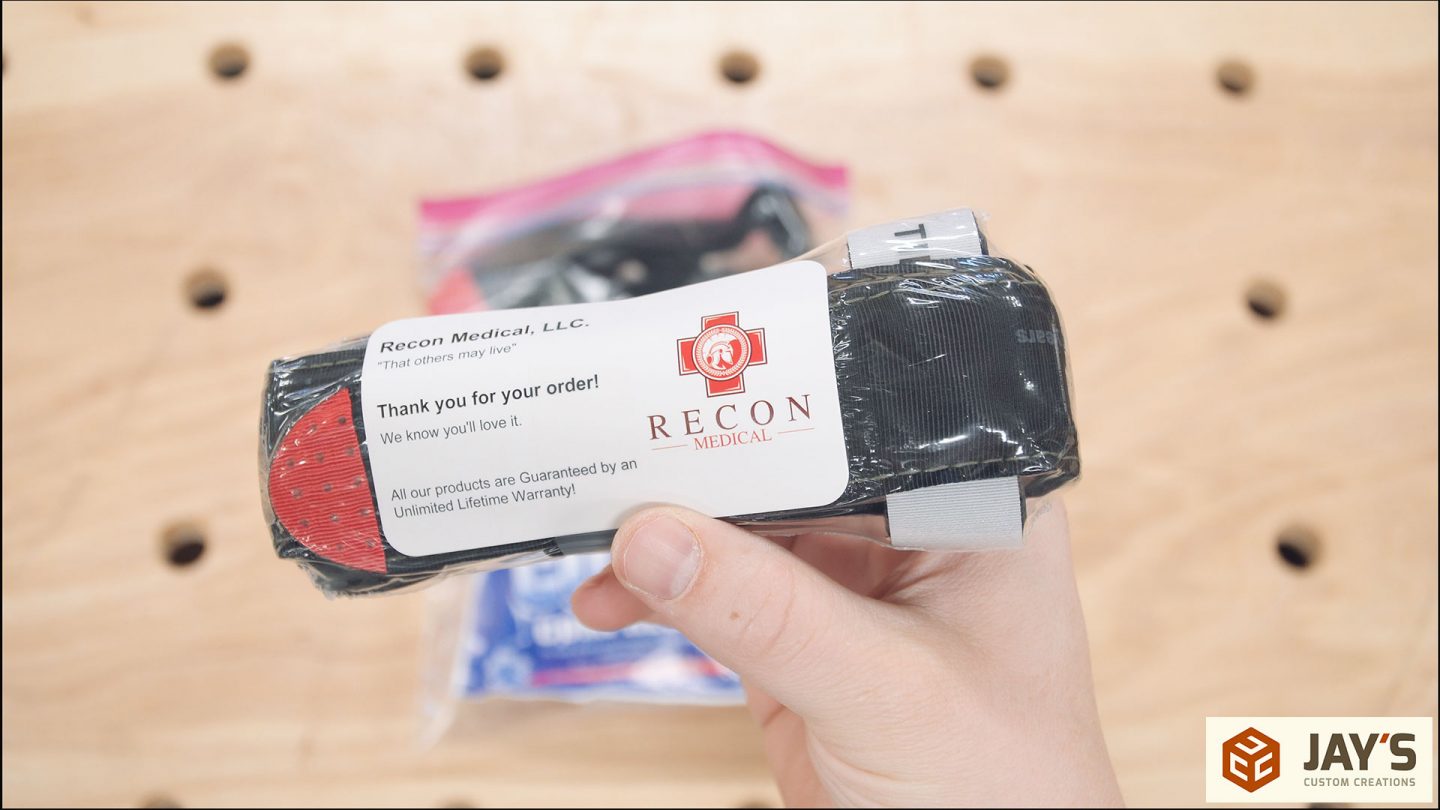
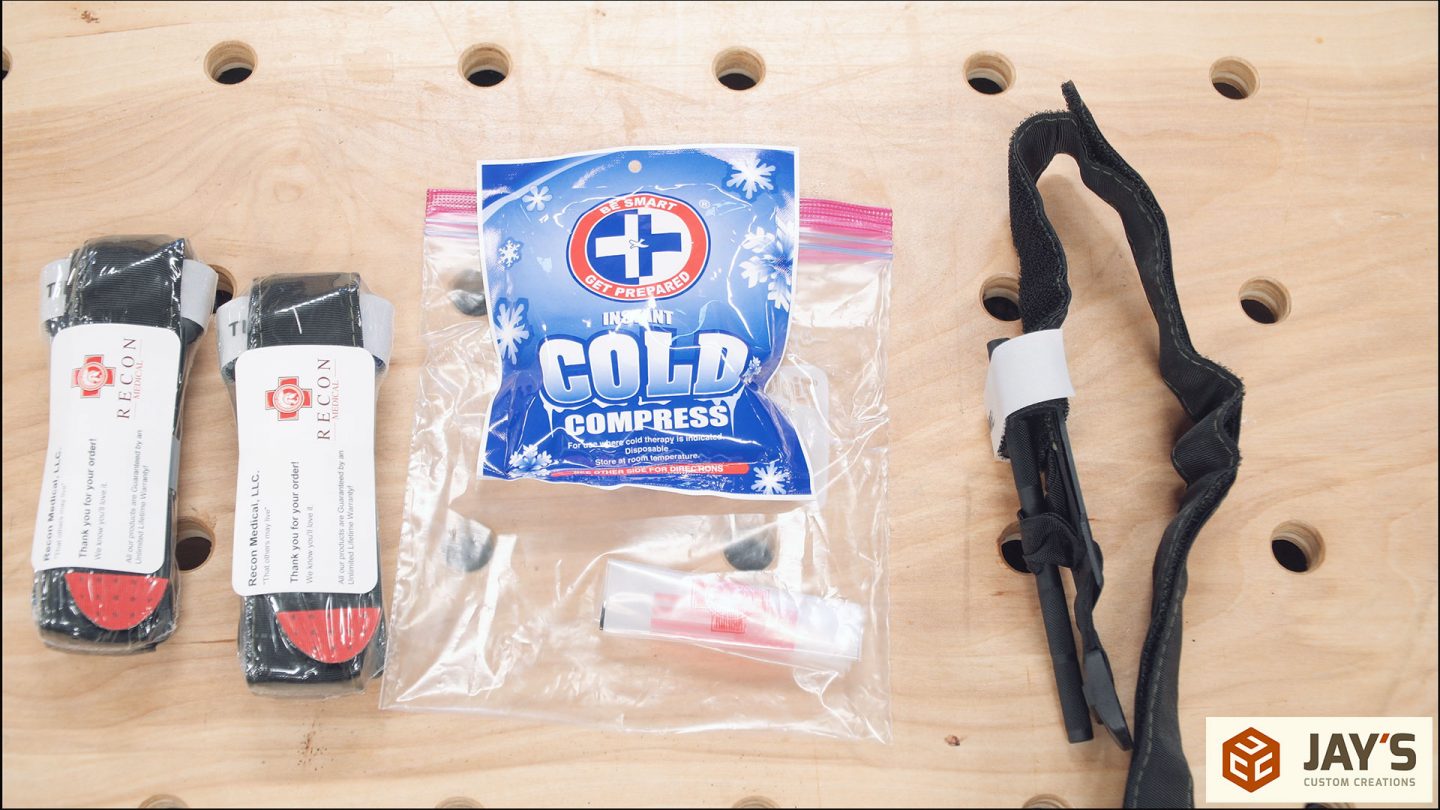
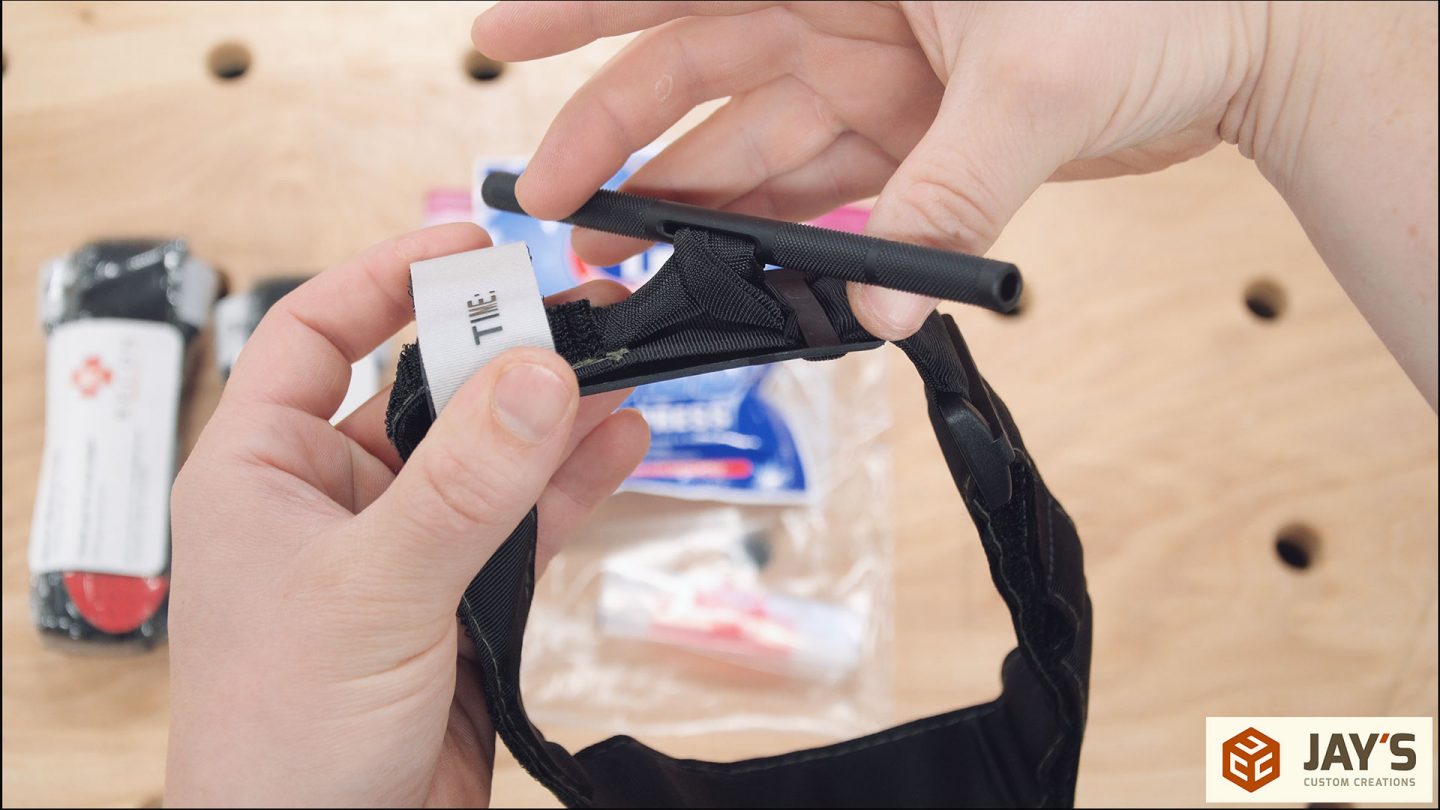
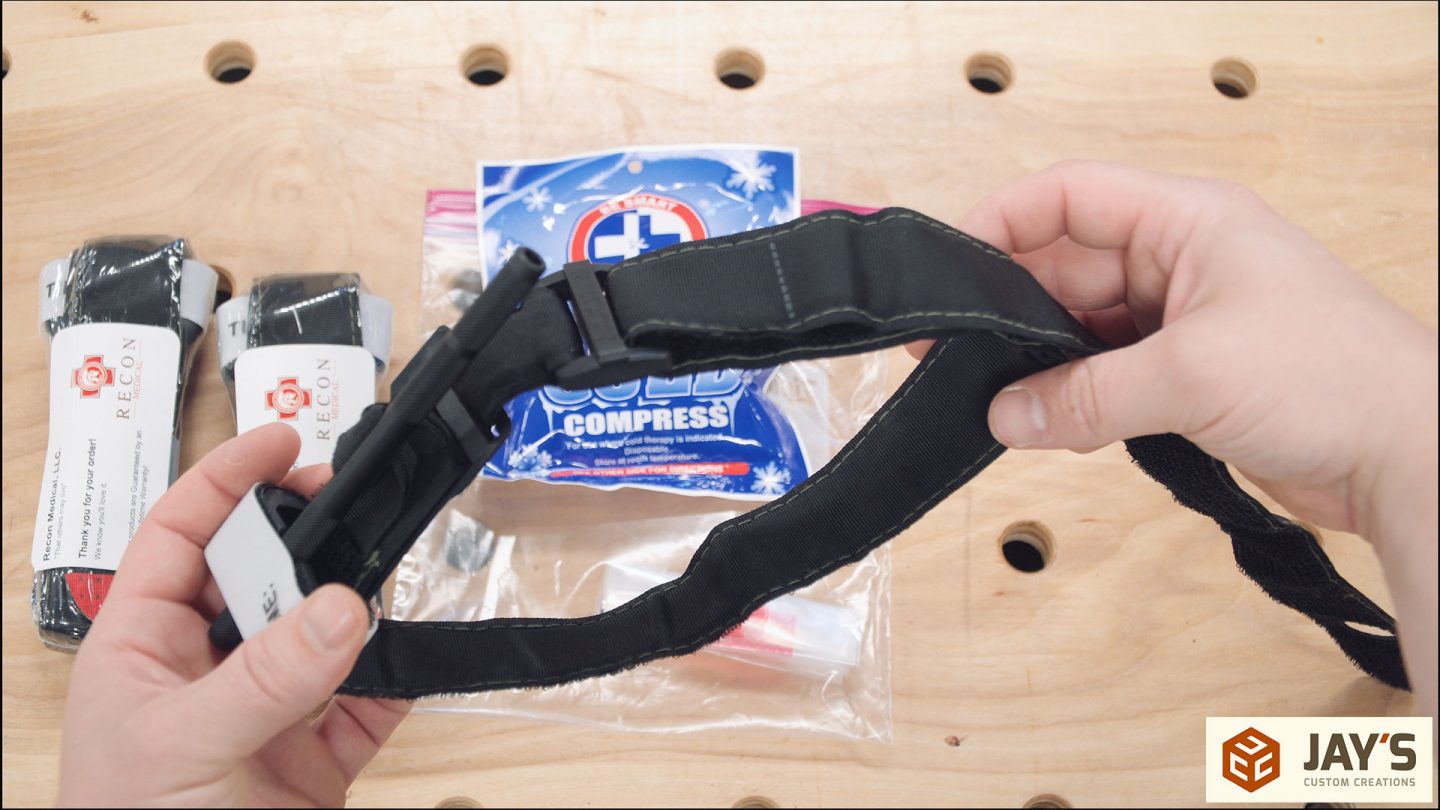 Fire Safety
Fire Safety
My neighbor is a firefighter. I asked him for advice on a fire extinguisher for the shop and he said that an ABC 10-pound extinguisher is what he would recommend. The ABC stands for the types of fire it can put out; wood and trash, liquids, and electrical. Regarding the size, he said if a 10-pound extinguisher can’t put the fire out then you just need to get out. I think that’s one of the best pieces of advice I could have heard. Where do you draw the line of trying to save stuff vs saving yourself? It makes sense. Try to put the fire out but if you can’t then get out of the danger area.
I happen to have 4 extinguishers now. I brought two 4-pound extinguishers from my last shop and bought a new 10-pound extinguisher for this space. Around the same time I got a new 10-pound extinguisher, my neighbor gave me another 10-pound extinguisher. So now I have four and keep them on each wall of the shop.
One tool I immediately think of regarding starting fires is the CNC machine. I worked at Ashley Furniture in their frame mill where there were a dozen or so CNC machines running at all times. I saw a few fires started by CNC machines while working there. Sometimes the program can go haywire or the person running the CNC makes an error and the spindle plunges into the material and sits there. A spinning bit buried in the material is a great way to start a friction fire. If you have a CNC machine please keep a fire extinguisher nearby.
So what happens if you can’t put the fire out? You get out, hopefully safely and quickly. Egress is something that shouldn’t be overlooked. A direct, unobstructed path out of the shop is a must. In my last shop, I moved tools around a lot and in more than one situation I found a layout that was great for working and horrible for escaping. I know the greatest limitation for everyone’s shop layout is the size of the space but keep egress in mind when placing stationary tools. It doesn’t make much sense to block exit paths.
Conclusion
Shop safety is just like maintenance in that it’s often not a high priority. With proper maintenance, your tools will continue to be prepared for use. With a little effort put into general shop safety, PPE, and first aid you will hopefully be prepared for unexpected accidents.
As I said, I’m not an expert in this field. I’m sure I overlooked some stuff in this article and video so I want your input if you have any. Leave a comment and continue the discussion below. Everything you add to the discussion will likely help someone else. Thanks!
Additional Resources
Search redcross.org for training in your area https://www.redcross.org/take-a-class/first-aid/first-aid-training
Fine Woodworking cutting edge first aid https://www.finewoodworking.com/2010/10/28/cutting-edge-first-aid
Build an air cleaner cart https://jayscustomcreations.com/2016/05/mobile-air-cleaner-cart/
Dylos air quality monitor https://amzn.to/3aADJ5T
Test the seal 3M https://multimedia.3m.com/mws/media/40742O/3m-elastomeric-half-facepiece-respirator-fitting-poster.pdf
3M Lifespan https://multimedia.3m.com/mws/media/447121O/filter-change-out-brochure.pdf
The dust explosion myth http://cliffsgarage.tv/articles/dustExplosion.html
Clean and maintain your respirator https://www.youtube.com/watch?v=Jp1XQ-7gtWc
A woodworker’s first aid kit by The Wood Whisperer https://www.youtube.com/watch?v=GF-iKbmQzFc







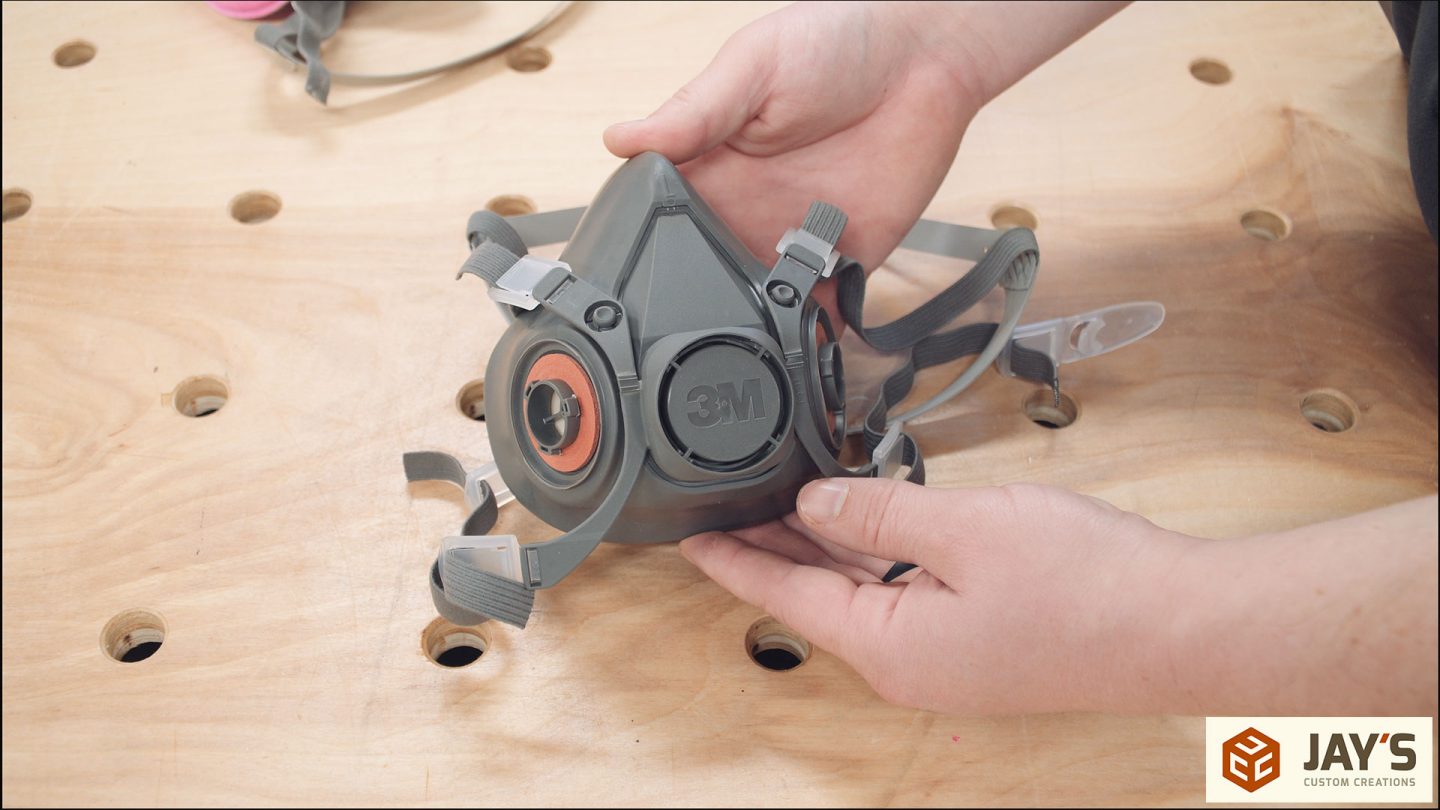
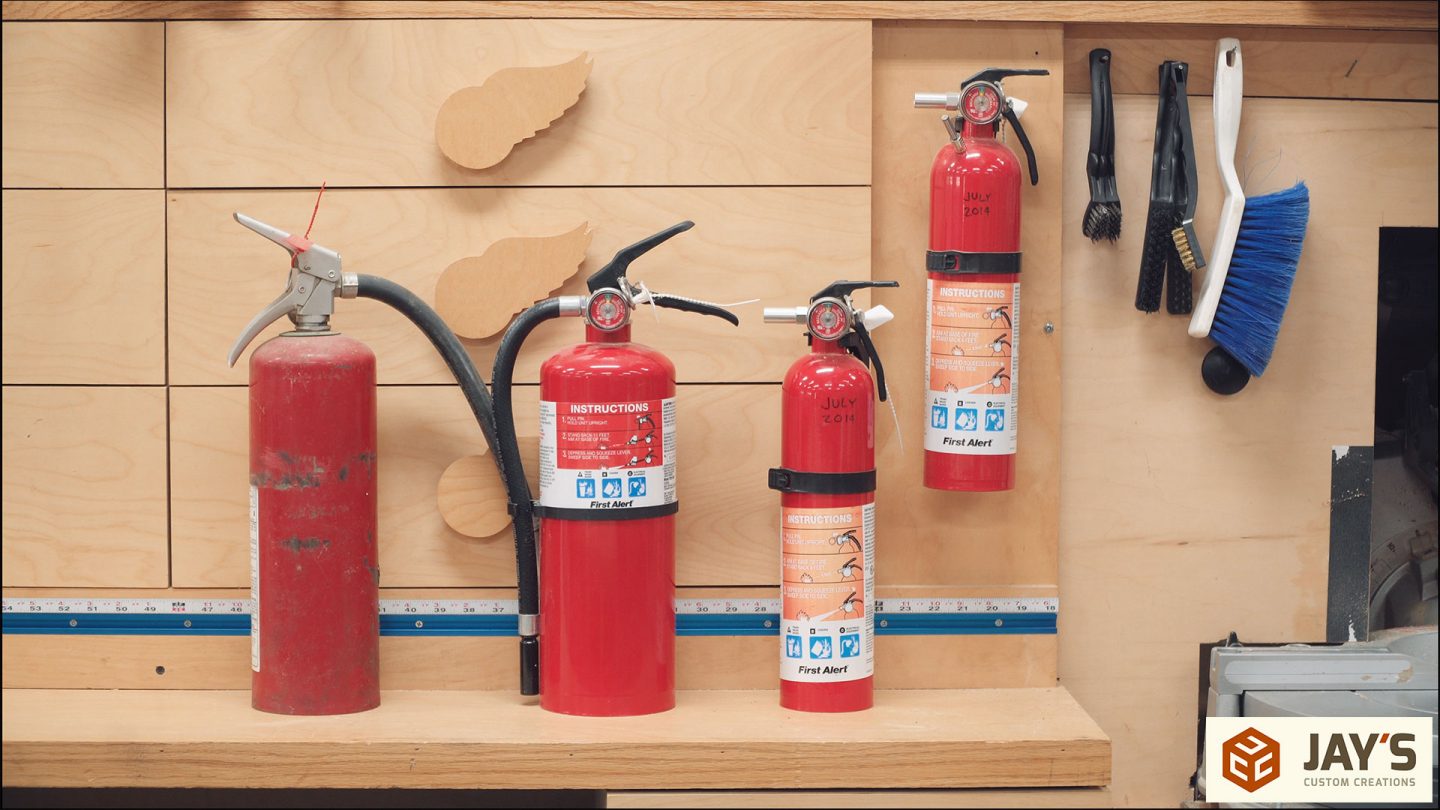
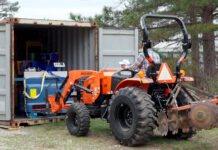
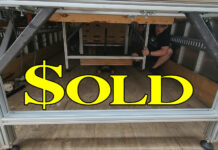
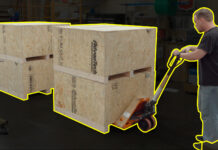
Well I guess the first comment is concerning the “1,2,3” thing you talked about. If you have 1 then you have none. Probably doesn’t count when referring to a wife. On a serious note, I have a thumbnail that splits. I maintain that nail with a coating of CA glue. And finally, I think most cellphone cameras have a 10x zoom. It works great to discern real small things. And you can use it with a good set of tweezers to remove splinters.
Brilliant compilation and presentation of vital information. Having been a high school workshop teacher for 30+ years, I believe it is never too late and always timely to address matters of safety.
Congratulations, a great piece of work!
Re specs, buy lots and hang one by each machine. Smoked specs means you will wear them outside instead of just sunglasses. Just beware outside on a windy day dust can swirl from you chopsaw into your eyes, resulting in an afternoon in hospital…..
Re plasters, kids plasters are usually the best, I have 2 dragon plasters on my fingers at the moment!
Eye protection. What about those of us that have to wear corrective lenses? (Contacts are not an option for me, medically.) Will your preferred choices fit over eyeglasses?
Depending on what you need you can order prescription safety glasses from a number of places. Your optician may be able to provide them for you also. If you are like me and just need readers DeWalt makes a pair of safety glasses with bifocal reader lenses in them in various strengths. I have a pair and they really work well and are comfortable.
I’ll second Hal’s comment. Prescription safety glasses were one of the smartest investments I ever made. I find them to stand up to paint, metal shavings, sand and grit as well as the sorts of normal splinters and dust of woodworking. I have progressive lenses optimized for close work (reading and soldering SMT electronics), medium distance (watching TV, instrument panel of the car), and far distance (driving, skiing, duck hunting) and they are transition lenses (auto darkening and 100% UV filtering).
Only downside is that they are in an oversized “aviator” style that looks really dorky, especially with the side shields on. But after years of fogging up “safety goggles” that were always scratched, dirty, or smeared with glue/paint/snot, I am really glad that I bit the bullet and had real shop glasses made.
My eyewear is a little different. In addition to being extremely nearsighted, I also suffer from Left Superior Oblique Palsy, which means one of the muscles in my left eye doesn’t pull my eye in line with my right one. So I see double. I have to have a prism in my left lens. So, prescription glasses are rather expensive for me. And it changes over the course of a year so that I have to get a new prescription each year. I can barely afford my primary glasses, much less another one that would probably be more expensive.
What I was hoping for was a recommendation on safety glasses that would fit over my normal glasses.
I would suggest you go with a full face shield, like the UVEX by Honeywell Bionic Face Shield. They are comfortable and you can easily replace the clear plastic part.
Bill – Many years ago, I was looking around at Walmart for a new set of frames. I looked in the safety section and found a set that looked really nice and were rated ANSI Z87 for safety. I bought them. They weren’t any more expensive then the standard frames and have outlasted them by a bunch. I just installed my fourth set of lenses in one pair. I ended up getting three pair of them and really like them. They are bigger than regular glasses, but not obnoxiously so. Mine are titanium and have really lasted. They also have removable side shields that I can put on when in the shop. I highly recommend taking a look at them.
Jay,
Well done and as usual, filled with great ideas, some flash back at me reminding me of what I should have either been doing or had in place all along …. thanks for putting this together.
Great info and a reminder to all. Clothing selection should also be considered a safety item. My father-in-law lost his hand in a miter saw when his long sleeve sweat shirt slipped and was grabbed by the saw. I quit wearing long sleeves around equipment like saws for that reason. I also wear a shop apron that help keep shavings from getting into clothing.
I use P100 organic filters until they no longer filter the organic vapors. Then I use them for dust particle filters.
You can also get safety glasses that are bifocals which are great for us older folks. For my welding shop work I have found you can get bifocal inserts that fit in your welding helmet too.
Stay safe!
Valuable and thoughtful public service. Thanks.
As a safety nerd, I loved the video. I do recommend the dust N95 cool flow masks from 3M. I used those for dust protection while powder coating sheet metal. I also noticed there is no containment for chemicals. Or something to contain chemical spills.Kinda like John Maleki’s Epoxy spill. Iloved everything you touched on. I do use splinter extractors/blade.
Excellent article, with 25 years as an EMT and woodworker, you gave spot on advice. Thank you. New Skin works great for small cuts and fingernail splits. The product is like a weak super glue but does not dry out in the glass jar. Been using the same jar for five years.
Excellent video. Thank you for going to all that work to publish it. I have used latex non-sterile and sterile gloves because I don’t have a latex allergy. My favorite nitrile glove is Venom Steel brand. [https://venomsteel.com/].
I can’t believe I sat here and you retained my interest for over an hour. Well done. I’m retired Army and former ski patroller. Can’t tell you how many safety/first aid classes I’ve endured and that is the right term for many of them. Yours on the other hand flowed, had enough show and tell and worked! Well done.
Jay and woodworking family, as usual thanks for hosting a great discussion and making it open to the community.
My thought or tip is to have multiples of the PPE you listed (glasses, muffs, disposable plugs, disposable respirators) for when friends/ family are present. I like to keep them at the ready and visible so that its convenient for those stopping by or entering the shop can protect at least their ears/ eyes before approaching. Each of my kids have their own set and know where to find them when it’s time to help. The spare stuff also comes in handy when I or others inevitably misplace a pair when I need them.
Like you mentioned, safety needs to be deliberate. No one plans to have an accident or even get a splinter but an ounce of prevention/preparedness can prevent a lot of lost time or regret.
Breathing protection. For several reasons too complicated to go into here, I do all my sawdust producing activities on the driveway. It seem to me that I don’t need a full blown respirator, all I need is a dust mask. (But better that simple one I am using for covid.)
What I think I want/need is a washable cloth mask, that covers my nose and mouth, with a one-way valve so that it isn’t so hot re-breathing my used air.
1. Is this a reasonable assumption, or do I really need a full respirator even when running a drill press or miter saw outside?
2. If this is reasonable, do you have a recommendation?
Good video, Jay. Once thing I would like to know about is safety glasses for small children. My three grandsons and granddaughter like to putter in the shop. I have one smaller pair that seem to be ok, but I was hoping you might know about others that you might recommend. I don’t remember where I got the pair I have, but need some more.
Everyone and I mean everyone should take a first aid with CPR course. You never know when you could save a loved ones life. Jay with a little one you should take a first aid course for Pediatrics. Little ones require a little different treatment. If you think you know CPR you don’t they have changed it and I was surprised why when I took it last year. St Johns Ambulance has an awesome course.
Your Video here was well done Jay and very informative. I picked up a few things. Thanks.
If you are working at the back of the shop and fire broke out at the door end of the shop how do you get out. As for my shop I have a man door at each end. That being said I do love your videos very informative thank you.
Thanks for putting all this together so well – from a retired paramedic and ER nurse:
1. Buy a small container (1 oz) of “Tincture of Benzoin.” This is a medical adhesive that you apply to undamaged skin to enhance the adhesion of Steri-Strips, “butterfly bandages,” band-aids, and the “skin closure” bandages you mentioned in the video. Benzoin does a great job keeping the sticky stuff stuck to what it’s supposed to stick to.
2. I think it is critical to keep your most important first-aid equipment at floor level. Think about this: If you sustain a significant injury in the shop, you may not be able to stand; you may have to crawl or drag yourself to the first aid kit. If it’s at chest level and you’re at floor level, you will have a problem…
3. Have several forms of communication. So many people have forsaken their hardwired phones. If you’re one of them, you should have your cell phone on your person at all times. Install an intercom system in your home. If you have Amazon or Google devices installed in your home, investigate and know how to use them to intercom others in the house, some can contact a friend or relative at a different location. Some devices are able to call 911 on your voice command, but your location will not be displayed at the emergency center. If you’re an amateur radio operator, keep a handy-talkie with you. Consider installing an exterior horn to signal neighbors that you’re in trouble. Whatever you do, you don’t want to be that person that is discovered after no one has seen you or heard from you for several days.
The P in the P100 filter rating means that it is Oil-‘P’roof. Not that it is only for “particles”.
R is ‘R’esistant to oil and N means ‘N’o protection from oils.
ex. N95 means no resistance to oil and 95% filtration of particles.
P100 is the best there is when it comes to both particle and oil filtration.
Hi Jay, excellent refresher on safety basics. Even when you know all these things, it is good to review them. In the PPE department I use a set of glasses/earmuffs calles Eye Muffs. They have a 22db noise reduction and easily fit over my normal glasses, which are actually high impact safety glasses, so I get double (?) protection. They run about $50 from eyemuffs.com.
In my 1st aid kit I also keep a blood clotting agent called WoundSeal. It is a powder to put directly on a serious cut that stops the blood and seals the wound until better medical assistance is available. I had use of it a few years ago when a piece of wood took off a finger tip. I was able to triage myself with WoundSeal and get the mess cleaned up enough (too much time in Viet Nam) that the ER doc only has to give me a tetanus shot and some pain killers. I also heep a can of NewSkin a liquid bandage spray. This is great for the many small scrapes and abrasions I get in the shop. The injury gets protected without fiddling with a bandaid.
An informative video as usual, Jay. I work alone in my shop and one item I have been considering purchasing is the QuikClot Advanced Clotting Gauze. Short of an amputation, where I might be hard pressed to self-apply a tourniquet, these seems like a potential way to prevent bleeding out before I am able to summon help.
Does anyone else have any thoughts on this product?
For hearing protection, I have some 3M ear muffs with builtin sound amplification. These amplify normal sounds such as talking or music, but cut out at louder sounds. Like most ear muffs, they are NRR 25. I also have a pair of Walker amplified ear plugs that work the same way. I think they are around NRR 28. Ear plugs are more comfortable with safety glasses. I like the amplified sound system because I can keep them on all the time and still hear normal ambient sounds like my radio, or the phone, or if someone comes in to chat, and I still have good protection when running tools. Check out ‘amplified hearing protection’ on Amazon. One thing to check is if they protect against extended lout noises. I got one pair of ear plugs that only block loud noise for about a half second then go back to amplification. I use them for shooting, but they are not useful in the shop.
I agree that having some basic first aid equipment in the shop would be a good idea. My son has been interested in woodworking, and I would want to make sure that we are both as safe as possible while in the shop. I’ll have to consider getting him some first aid training, as well as the equipment, so he knows what to do if there is an emergency.